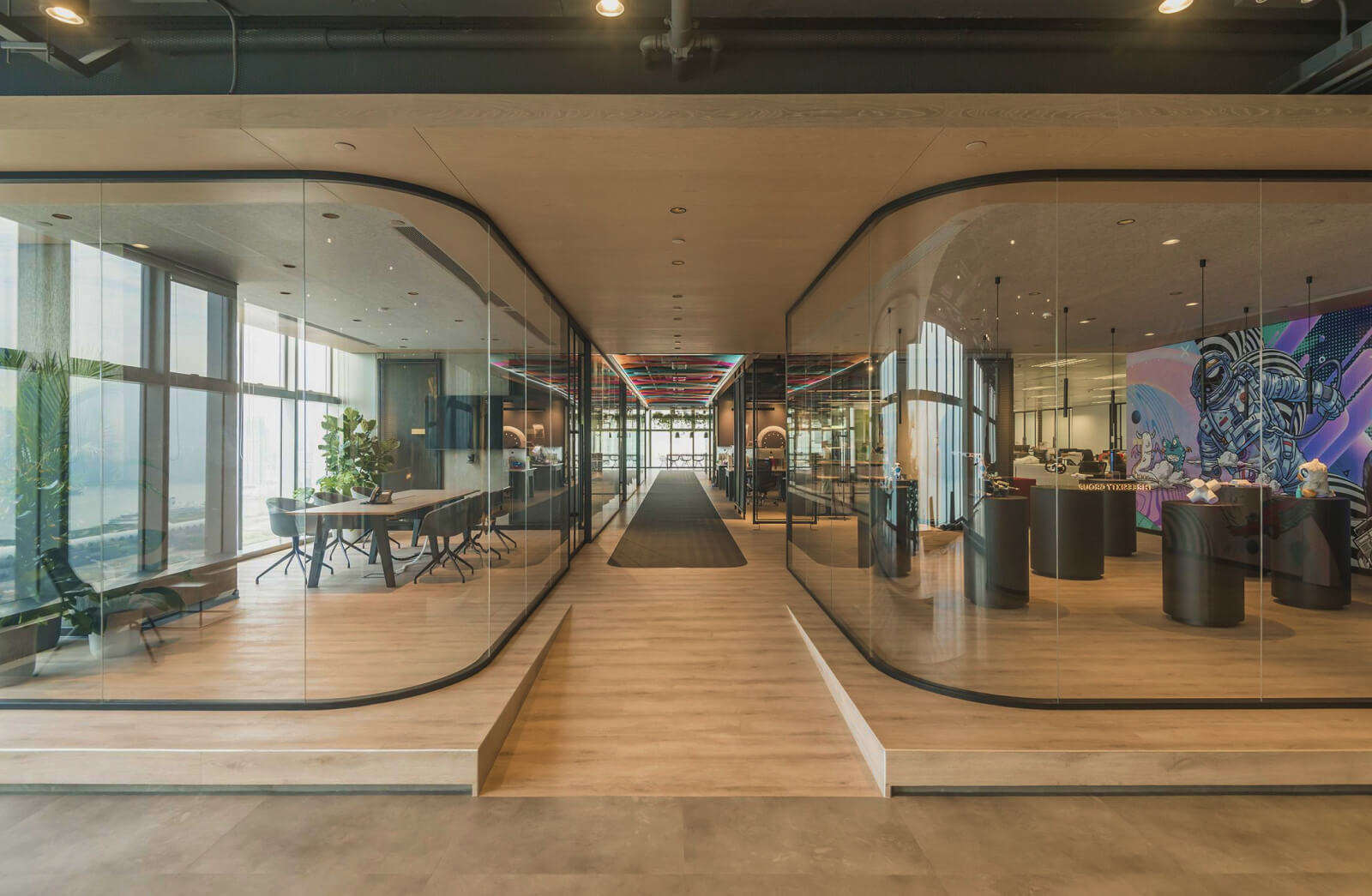
Curved glass partition walls are redefining the boundaries of spatial design. Unlike flat glass panels, their smooth, flowing forms introduce a sense of movement, softness, and elegance into a space. By following organic lines rather than rigid angles, curved glass transforms interiors with subtle drama and architectural sophistication. These partitions allow light to travel freely, enhance sightlines, and create a more open atmosphere without sacrificing privacy or function. Their uniqueness lies in this blend of visual fluidity and structural precision—a marriage of aesthetics and engineering that few materials can offer.
This guide is created for designers, architects, developers, and businesses looking to craft distinctive, contemporary spaces. Here, you’ll discover how to approach the design process, the benefits curved glass offers, and where it’s being used most effectively. The goal is to give you practical insight and creative direction for your next project.
What Is a Curved Glass Partition Wall?
A curved glass partition wall is a non-load-bearing interior feature crafted from glass that has been custom-formed into a smooth, continuous curve. Unlike traditional flat partitions, curved glass introduces softness and movement into spaces, blurring the line between structure and sculpture. The glass is typically made from tempered or laminated materials to ensure strength, safety, and longevity. Tempered glass is heat-treated to resist impact and, if broken, fractures into small, less harmful pieces. Laminated glass consists of multiple layers bonded by a protective interlayer, which holds the glass together even when cracked. Both types can be finished in clear, frosted, tinted, or patterned options, depending on the privacy and style needs of the space.
What sets curved glass partitions apart is their ability to transform the feel of a space without adding visual weight. Their unique form creates fluid transitions, softens hard architectural lines, and introduces a sense of movement and flow. The curvature can subtly guide the eye, suggest direction, or define zones within open-plan layouts, all while retaining an airy, minimalist aesthetic. This combination of structural precision and organic beauty is rare, making curved glass an architectural feature that’s both functional and emotionally resonant. You’ll often find these partitions in modern offices, where they delineate meeting rooms or private workspaces. They also shine in luxury homes, boutique hotels, galleries, and high-end retail spaces. Wherever they’re used, curved glass partitions bring a sense of refinement, innovation, and intentional design.
Why Choose a Curved Glass Partition?
1. A Sculptural form in functional design
What truly sets curved glass apart is its sculptural quality. It turns a practical element, a wall, into something almost artistic. The arc of glass becomes a gentle gesture through space, softening hard edges and adding dimension to otherwise flat environments.
2. Light that blends with space
Curved glass has a distinct relationship with light. Its shape bends, reflects, and refracts natural and artificial light in ways flat glass cannot, creating dynamic shadows, glowing edges, and a greater sense of openness.
3. Organic flow meets spatial logic
Functionally, curved partitions create boundaries, but they do so with an organic rhythm. This allows for intuitive navigation and more natural spatial flow, as the curve gently guides people through a space. Unlike linear divisions that can feel abrupt or confined, curved glass encourages movement, softens transitions, and supports flexible layouts without compromising structure or order.
4. Symbol of innovation and design maturity
Incorporating curved glass reflects an elevated design sensibility; one that values craft, precision, and innovation. It’s a bold yet refined choice that signals intention: the space isn’t just functional, it’s thoughtfully composed. From luxury residences to modern offices, it speaks of a brand or homeowner who prioritizes beauty, clarity, and a forward-thinking design philosophy.
Design Considerations for Curved Glass Partitions
1. Glass thickness and radius of curvature
The thickness and curvature of the glass make a unique statement in any space. The thickness determines not just structural stability but also the tactile experience; thicker glass feels more substantial, providing a sense of security, while thinner glass can convey a delicate, almost ethereal lightness. The radius of curvature further distinguishes a curved glass partition by allowing designers to achieve everything from subtle, soft arcs to bold, sweeping curves that redefine the flow of the room, allowing it to evolve from rigid geometry to something that visually flows, enhancing both movement and energy.
2. Frameless vs framed options
The choice between frameless and framed curved glass partitions introduces a unique opportunity to express the vision of a space. Frameless glass is a hallmark of modern, minimalist design; its smooth edges and seamless integration into the environment provide an uninterrupted, unobtrusive aesthetic. On the other hand, framed partitions offer a chance to introduce texture, material contrast, and a sense of structure. The frame becomes a powerful design feature in itself, creating a balance of strength and elegance.
Related Read: Frameless vs. Framed Glass Partitions
3. Privacy options
Privacy options make curved glass partitions exceptionally versatile. Frosted glass offers a soft, translucent look while maintaining openness, and tinted glass reduces glare and adds ambiance. Smart glass goes a step further, allowing privacy to be controlled at the touch of a button, offering flexibility and adaptability.
4. Acoustic performance factors
Glass, by nature, isn’t known for soundproofing, but by incorporating double-glazed or acoustic laminated glass, or using sound-dampening interlayers, a curved glass partition can effectively mitigate noise transmission. The curve itself further enhances this uniqueness by redirecting sound waves in ways flat panels can’t.
Installation Insights: What to Expect
1. Key steps in installation
Every project begins with a comprehensive site survey. We take precise measurements and assess structural conditions to ensure compatibility and safety. From there, our team oversees the custom shaping and fabrication of the curved glass, using high-grade materials like tempered or laminated glass for strength and clarity. Once ready, our expert installers handle the on-site fitting, executing each curve with exact alignment and minimal disruption.
2. Importance of professional installation
Curved glass partitions demand more than just good design, they require a deep understanding of load, tension, and architectural flow. Professional installers ensure that the glass is not only safely anchored but also seamlessly integrated into its frame or mount system, because the slightest misalignment can compromise the curve’s fluidity or cause stress fractures. Professional handling minimizes risks, ensures longevity, and preserves the design intent.
3. Lead time & site prep recommendations
Because every curved partition is custom-fabricated, lead times typically range from 1 to 2 weeks, depending on the scope and glass specifications. We make it a priority to communicate your specific project’s lead time upfront, so timelines are clear and expectations are aligned. We also recommend that floors are leveled, ceiling tracks (if applicable) are prepared, and access is clear for safe delivery and handling. Our team provides clear prep checklists to ensure installation goes smoothly.
Cost Factors for Curved Glass Partitions
1. Factors affecting cost
Several factors influence the final cost of a curved glass partition. The type of glass; whether it’s clear, tinted, frosted, laminated, or smart glass, plays a major role, as each offers varying levels of complexity and performance. The size and radius of curvature also impact pricing, with tighter curves often requiring more advanced shaping techniques. Additionally, the fittings and framing systems; frameless versus framed, floor-to-ceiling versus partial height can shift costs depending on material choices, structural requirements, and finish levels. Complexity in site conditions, HVAC, and flooring may also contribute to project scope and pricing.
2. Typical price range in the UK
In the UK, the cost of curved glass partitions varies widely depending on the above factors. On average, you can expect to pay between £800 to £4500 per meter, but, may fluctuate based on location, customisation, and integration with other architectural features. For premium finishes or advanced glass technologies (like smart glass), prices can exceed this range. While the upfront investment is higher than flat glass or drywall partitions, curved glass delivers a completely different caliber of design and experience. For an accurate quotation for your project, it’s best to reach out to our team.
3. Weighing cost against long-term value
Though curved glass partitions may carry a higher initial cost, their long-term value often outweighs the investment. Their durability, resistance to wear, and minimal maintenance needs contribute to lower lifecycle costs compared to other materials. They also enhance natural light flow, reduce the need for artificial lighting, and elevate property appeal, especially in high-end residential, hospitality, and commercial environments. This way, curved glass partitions are not just functional, they’re an architectural upgrade that holds long-term design and resale value.
Maintenance and Durability
Curved glass partitions are designed to stand the test of time, but proper care ensures they maintain their beauty and function over the years.
1. How to care for curved glass partitions
To maintain the clarity and sheen of your curved glass partitions, regularly clean them with a gentle, non-abrasive cleaner and a soft cloth to avoid scratches. For hard water stains, a vinegar-water solution can help remove build-up without damaging the surface. Also, ensure that the frame, if applicable, is wiped down periodically to prevent dust accumulation.
2. Scratch resistance and longevity considerations
Curved glass is typically tempered or laminated, offering strong resistance to scratches and impacts. However, it’s important to avoid harsh abrasive materials or cleaning tools that could compromise its finish. With proper care, these partitions are built to last decades, maintaining their structural integrity and aesthetic appeal through sustained use.
3. When repairs or replacements might be needed
Although rare, cracks or chips can occur from significant impact. If this happens, it’s essential to consult a professional to assess whether a repair or replacement is necessary. Regular inspections also help detect potential issues like frame wear or glass fogging, preventing costly repairs down the line.
Curved Glass Partitions vs. Straight Glass Partitions
When deciding between curved and straight glass partitions, it’s essential to understand their visual appeal, practical benefits, and how each can enhance a space differently.
| Feature | Curved glass partitions | Straight glass partitions |
|---|---|---|
| Aesthetics | Curved glass partitions bring a dynamic flow to spaces, offering elegance and fluidity. They soften sharp angles, create a continuous, bold aesthetic, and draw the eye, making them a striking feature in any environment. | Straight glass partitions offer a clean, sharp aesthetic, emphasizing precision and minimalism, ideal for modern, structured spaces. |
| Advantages and Limitations | The flowing design of curved glass enhances light distribution, making spaces feel more expansive and seamless. However, their intricate installation and higher cost require careful planning and professional expertise. | Straight partitions are easy to install and more cost-effective, offering a straightforward solution for dividing space without compromising on transparency. Their geometric precision is well-suited for projects where functionality and practicality are prioritized. |
| Best Fit | They are perfect for luxury homes, high-end offices, and hotel lobbies where creating a bold, sophisticated atmosphere is essential. They excel in open spaces where a fluid, open design is desired. | They are ideal for corporate offices, commercial environments, and budget-conscious projects where clear spatial separation is needed, without the need for complex design elements. |
FAQs
The minimum radius for curved glass partitions typically depends on the thickness of the glass and the type of curvature. Generally, the radius can range from 500mm to 1 meter, ensuring both structural integrity and aesthetic appeal.
Yes, curved glass tends to be more expensive than straight glass due to the complex manufacturing process and the need for custom shaping. The additional costs are reflected in the labor-intensive installation and the specialized materials used.
Absolutely! Curved glass partitions can be customized with frosted glass, tinted options, and smart glass that adjusts opacity.
Manufacturing and installation typically take between 2 to 4 weeks, depending on the complexity of the design and the size of the space. This timeline includes site assessments, custom shaping, and professional installation to ensure a flawless finish.
es, curved glass partitions are safe for office environments. They are made from tempered or laminated glass, which is specifically designed to be strong, shatter-resistant, and compliant with safety standards, ensuring durability and protection in busy spaces.














